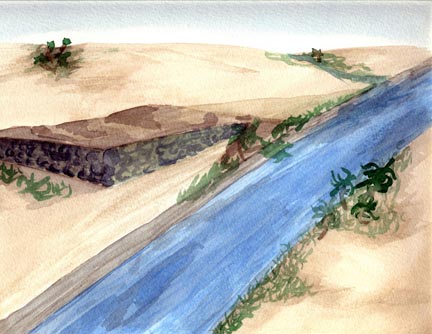The Harappan Civilization utilized a diverse assemblage of wild and
domestic plants in the production of food and industrial products.
Animal production centered on zebu cattle, buffalo, sheep, goats,
fish, chicken, and some wild species. Agricultural foods were produced
through two means of production. The older and more widespread was
based to the north and west, in Balochistan, the Banna Basin, Sind,
Punjab, Swat, and Kashmir (Werber, 1999).Crops of barley, wheat, oats,
lentils, chick and grass peas, jujube, and mustard were sown in
autumn, harvested in spring, and watered by winter rains (Werber,
1999). In the
second, crops such as millits, sorghum, rice, cotton, and dates and
were sown in the summer to be watered by the summer monsoon and
harvested in the fall (Possehl, 2002). This method was located in the
Gujarat and western India (Sauashtra, Kutch, Rajasthan, and Mahashtra) (Possehl,
2002). As time passed the people of both areas
diversified and intensified their food production by incorporating
both techniques (Werber, 1999).
In the interior, the emphasis was on cattle (Shaffer and
Lichtenstein, 1989). In Mesopotamia and most other early agricultural
communities, a primary emphasis was on grain with goats and sheep to
provide fats and protein (Shaffer and Lichtenstein, 1989). In southern
Baluchistan, the highlands were dense with transhumant pastoral nomads (Possehl,
1986). Annually, these nomads would drive their cattle to market in the
Indus Valley. They would then sell their services as itinerant field
laborers, many likely served as traders and tinkers as is the case
today.
At Balakot on the east side of Sonmiani Bay, the inhabitants were
found to be utilizing fish and molluscs for food (Dales and Kenoyer,
1977). Evidence from Harappa suggests that large amounts of dried fish
were moved inland from the costal areas (Belcher, 1991). These fish
resources were utilized by much of the population, suggesting their
abundance and low cost.
Differing agricultural methods were utilized in each area of the
Harappan Civilization. In the northwest the Harappans utilized the plow
to open the earth. At Kalibangan, fields were plowed twice, the second
at 90o to the first (Sharma, 1999). This would have allowed
for two crops to be planted at once in the same field. This method is
sill in use regionally today.
In the areas dominated by rivers, the Harappans utilized neither
irrigation nor the plow. They used annual river
 flooding to deposit fertile hydrated
soil onto the fields. This soil was concentrated in to fields by the use
of ‘L’ shaped land bound damns placed along watercourses (Figure 3) (Possehl,
1975). In Southern Baluchistan, the Harappans utilized plays, naturally
watered features (Possehl, 1986).
flooding to deposit fertile hydrated
soil onto the fields. This soil was concentrated in to fields by the use
of ‘L’ shaped land bound damns placed along watercourses (Figure 3) (Possehl,
1975). In Southern Baluchistan, the Harappans utilized plays, naturally
watered features (Possehl, 1986).
The site of Harappa was first settled c. 3300 B.C.E. At that time,
barley was utilized as the primary food crop. With the rise of the
Harappan Civilization, a shift occurred in which wheat, dominant in the
southwest, became the staple crop (Werber, 1999). By the end of the Late
Harappan, barley had once again asserted itself (Werber, 1999).



